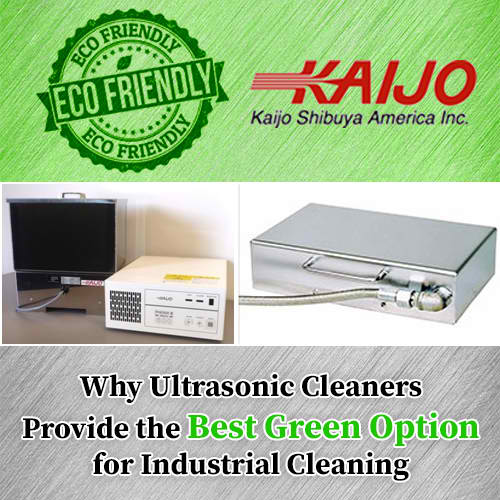Why Ultrasonic Cleaners Provide the Best Green Option for Industrial Cleaning
February 19, 2020
 Ultrasonic cleaning systems offer superior cleaning performance as well as a cleaner environmental footprint. Where traditional cleaning methods use toxic chemicals and require manual scrubbing or other mechanical cleaning, ultrasonic cleaners use plain water or mild detergents to clean parts quickly and completely. The work environment is safer for workers and free of aggressive chemicals that require special protective measures.
Ultrasonic cleaning systems offer superior cleaning performance as well as a cleaner environmental footprint. Where traditional cleaning methods use toxic chemicals and require manual scrubbing or other mechanical cleaning, ultrasonic cleaners use plain water or mild detergents to clean parts quickly and completely. The work environment is safer for workers and free of aggressive chemicals that require special protective measures.
When such chemicals no longer have to be purchased, stored, handled or neutralized after use, cleaning costs are reduced and productivity improves. As environmental legislation and worker safety regulations become more strict, ultrasonic cleaning systems are the wave of the future, offering excellent cleaning solutions to a variety of cleaning applications.
Why Ultrasonic Cleaning Does Not Need Aggressive Chemicals
When cleaning involves using chemicals to dissolve surface contaminants on parts, the chemicals have to be aggressive to completely clean part surfaces in a reasonable time. Even then, some cleaning applications require long periods of soaking and a final step of mechanical scrubbing to get rid of the last traces of surface contaminants. The chemicals used are expensive to buy and difficult to handle safely. Mechanical scrubbing is labor-intensive and can damage the parts to be cleaned.
Ultrasonic cleaning relies on a mechanical process that completely cleans surfaces without any chemical action. Ultrasonic transducers create high-frequency sound waves in the cleaning solution and the sound waves in turn produce microscopic cavitation bubbles in their low-pressure troughs. These bubbles collapse in the high-pressure peaks of the sound waves, releasing a jet of cleaning solution that strikes the part surface, dislodging any dirt particles. This mechanical scrubbing action of the bubbles cleans rapidly and even cleans inside holes and crevices.
For some cleaning applications, contaminants include heavy deposits of grease or oily residue that are hard to remove. In such cases heating the cleaning solution or using a detergent can help the ultrasonic bubbles to do their job. Heating the bath to around 80 degrees Fahrenheit softens hard deposits and the detergents can be mild solvents that don’t need any special handling. No strong chemicals are required for the ultrasonic cleaning process.
Why Green Ultrasonic Cleaning Delivers the Most Benefits
Ultrasonic cleaning systems deliver environmentally friendly cleaning due to their lack of toxic by-products but they also provide many other benefits. Avoiding the use of chemicals has implications for the whole cleaning facility in terms of operating costs and work environment. Specific advantages include:
• Lower operating costs due to savings on the purchase of expensive cleaning chemicals
• Lower capital costs because special storage tanks, chemical handling and chemical disposal facilities are not required
• Lower compliance costs because safety and environmental issues are fewer
• Safer work environment due to the absence of hazardous materials
• Improved productivity because ultrasonic cleaning is faster than traditional methods
• Improved community relations because the facility is no longer seen as a source of toxic waste
• Improved company image through efforts to reduce chemical use and develop a green, environmentally friendly production line
Few transitions to greener operations can offer as many benefits as the replacement of chemicals-based cleaning with ultrasonic cleaning systems.
How to Transition to Green Ultrasonic Cleaning
Based on the company’s extensive experience with ultrasonic technology and in house development work, Kaijo can help companies replace traditional cleaning systems with ultrasonic solutions. Kaijo has a complete line of ultrasonic cleaners ranging from turnkey solutions to custom-built systems. Sometimes individual components can be used with existing facility cleaning tanks and custom cleaners can be integrated into production lines. Kaijo can analyze the needs of a customer, propose the best ultrasonic cleaning solution, and recommend specific equipment to ensure that it delivers the cleaning performance required.





